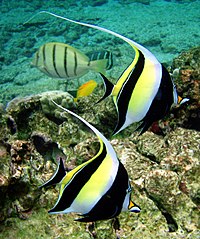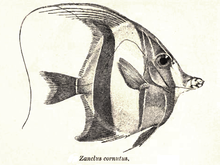Moorish idol
| Moorish idol | |
|---|---|

| |
| Scientific classification | |
| Domain: | Eukaryota |
| Kingdom: | Animalia |
| Phylum: | Chordata |
| Class: | Actinopterygii |
| Order: | Acanthuriformes |
| Suborder: | Acanthuroidei |
| Family: | Zanclidae |
| Genus: | Zanclus Cuvier in Cuvier and Valenciennes, 1831 |
| Species: | Z. cornutus
|
| Binomial name | |
| Zanclus cornutus | |
| Synonyms[2] | |
| |
The Moorish idol (Zanclus cornutus) is a species of marine
Taxonomy
The Moorish idol was first formally
Etymology
Moorish idol's unusual name was apparently given to it because in some areas of south-east Asia fishermen have respect for these fishes releasing them when caught and honouring them with a bow after their release.
Description

The Moorish idol's body is highly compressed and disc-like in shape with a tube-like snout and small bony protruberances above the eyes in adults. The mouth is small and has many long, bristle like teeth.
Distribution and habitat
The Moorish idol has a wide range in the Indian and Pacific Oceans. They are found from the eastern coast of Africa between Somalia and South Africa east to
Biology
Moorish idols feed on
In the aquarium

Moorish idols are notoriously difficult to maintain in captivity. They require large tanks, often exceeding 380 L (84 imp gal; 100 US gal),[13] are voracious eaters, and can become destructive.[13]
Some aquarists prefer to keep substitute species that look very similar to the Moorish idol. These substitutes are all butterflyfishes of the genus
Moorish idols typically are very picky eaters. They will either eat no food and perish, or eat everything all at once.[13]
Timeline

In popular culture
- In the 2003 end credits.[14]
- Moorish idols have long been among the most recognizable of shower curtains, blankets, towels and wallpaper made with an ocean or underwater theme.[citation needed]
References
- ^ . Retrieved 13 November 2021.
- ^ a b c Froese, Rainer; Pauly, Daniel (eds.) (2023). "Zanclus cornutus" in FishBase. February 2023 version.
- ^ Eschmeyer, William N.; Fricke, Ron & van der Laan, Richard (eds.). "Species in the genus Zanclus". Catalog of Fishes. California Academy of Sciences. Retrieved 10 July 2023.
- ^ Eschmeyer, William N.; Fricke, Ron & van der Laan, Richard (eds.). "Genera in the family Zanclidae". Catalog of Fishes. California Academy of Sciences. Retrieved 10 July 2023.
- PMID 25543675.
- ISBN 978-1-118-34233-6.
- ^ a b c d e f Kenneth Wingerter (24 October 2012). "Aquarium Fish: Reconsidering the Moorish Idol". reefs.com.
- ^ "IDOLE MAURE Zanclus cornutus (Linnaeus, 1758) N° 2225". doris.ffessm.fr (in French). Retrieved 10 July 2023.
- ^ Susan Scott (22 February 2016). "Common name for this fish is in need of an origin story". susanscott.net. Honolulu Star and Advertiser. Retrieved 10 July 2023.
- ^ Christopher Scharpf & Kenneth J. Lazara, eds. (12 January 2021). "Order ACANTHURIFORMES (part 2): Families EPHIPPIDAE, LEIOGNATHIDAE, SCATOPHAGIDAE, ANTIGONIIDAE, SIGANIDAE, CAPROIDAE, LUVARIDAE, ZANCLIDAE and ACANTHURIDAE". The ETYFish Project Fish Name Etymology Database. Christopher Scharpf and Kenneth J. Lazara. Retrieved 10 July 2023.
- ^ a b Bray, D.J. (2018). "Zanclus cornutus". Fishes of Australia. Museums Victoria. Retrieved 10 July 2023.
- ^ a b "Moorish idol". The Dallas World Aquarium. Retrieved 21 June 2023.
- ^ a b c "How to Care for One of the Most Difficult Aquarium Fish".
- ^ "Willem Dafoe Returns For 'Finding Dory': 'It's Even Better Than The First'". The Inquisitr. 6 October 2013. Retrieved 6 October 2013.
External links
- Photos of Moorish idol on Sealife Collection

